| Reviews & Columns |
|
Reviews DVD TV on DVD Blu-ray 4K UHD International DVDs In Theaters Reviews by Studio Video Games Features Collector Series DVDs Easter Egg Database Interviews DVD Talk Radio Feature Articles Columns Anime Talk DVD Savant Horror DVDs The M.O.D. Squad Art House HD Talk Silent DVD
|
DVD Talk Forum |
|
|
| Resources |
|
DVD Price Search Customer Service #'s RCE Info Links |
|
Columns
|
|
|
Herschell Gordon Lewis Feast, The
The Collection:
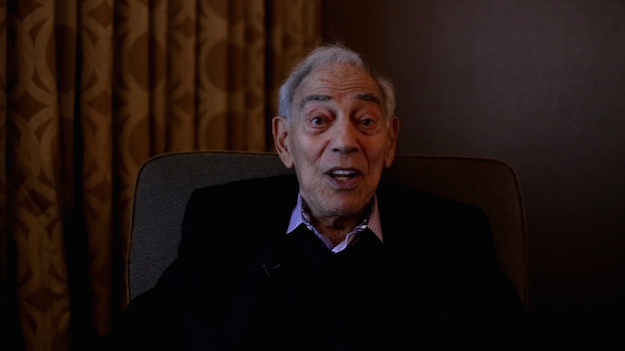
Herschell Gordon Lewis, "The Godfather of Gore," is not an artist. He says so himself. He is a businessman who found a way to make money in the '60s, in the world of exploitation filmmaking. After making some relatively successful nudist-camp movies and other "nudie cuties," Lewis realized there was a niche to be filled by offering never-before-seen images of blood and guts onscreen (as ever, America's puritanical censorship standards were more concerned with regulating sex than violence). It didn't matter if the acting was good or all the shots were in focus, just as long as audiences got their gruesome fill. Lewis would dip a toe in all sorts of exploitation subgenres over the next decade, making more than two dozen flicks, but his splatter epics are his signature work.
Arrow Video's new 14-film collection from Lewis (who passed away two short months ago), The Herschell Gordon Lewis Feast, is generously supplemented and ingeniously packaged in a faux-cereal box. Nine of the included films are making their HD debut, although it's worth noting that many of the titles have been so mistreated over the years that, even with a new 2K scan, they don't look particularly state-of-the-art (more on this in the A/V review below). Let's dig in.
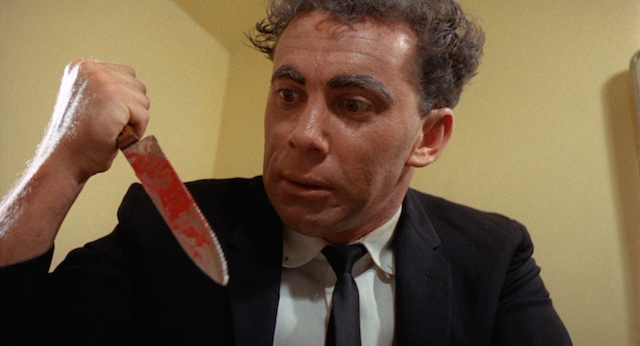
The set starts off with the film that made Lewis's name: 1963's Blood Feast. Horror fans coming to the film for the first time, intrigued by its reputation, might be in for a surprise. Blood Feast is not scary, it's full of stiff acting and it's not terribly well made in general (Lewis is the first to admit this, by the way). However, as the first "splatter film," what it has -- in abundance -- is fake blood and animal guts being unconvincingly pulled out of any number of adequate actresses. Gore effects got more sophisticated than this within the blink of an eye, but the way red Jell-o oozes out of Astrid Olson's mouth, after her tongue has been supposedly ripped out, is still oddly effective in its weird, homemade way. The plot, as it were, involves an Egyptian caterer with the amazing name of Fuad Ramses (Mal Arnold), who goes around chopping up ladies to create the titular blood feast to bring back Elaine May's unduly maligned Ishtar -- er, I mean, an Egyptian goddess named Ishtar. Much of the flick is fairly silly, but when a witness tells cop Bill Kerwin that the killer said he was doing it "for Ee-tar" -- and then our cop hero spends a good minute or so figuring out that "Ee-tar" and "Ishtar" might be the same thing -- the film is transmogrified into Bad Movie Nirvana.
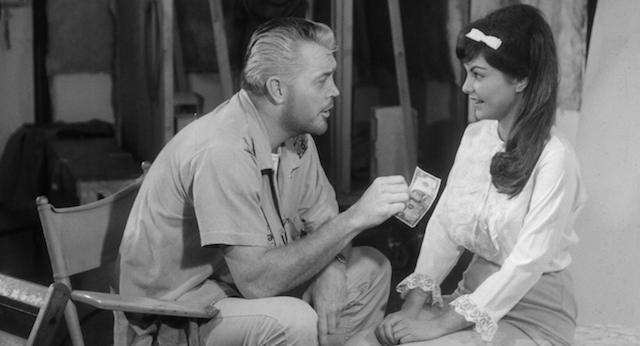
The next flick in the set was reportedly shot mere weeks after Blood Feast, and it's the sexploitation "roughie," Scum of the Earth. The film is Lewis's last effort in black-and-white, a choice which gives the proceedings a grittier flavor and which honestly looks better than most of the cinematographer-director's color films. Allison Louise Downe, the then-Mrs. Herschell Gordon Lewis, stars as a high school girl ensnared by some underworld hustlers into posing for dirty pictures. Bill Kerwin, made up to look older and worse for wear than in Blood Feast, is oddly compelling as the old-hand porn photographer who feels bad for all the girls that pass unwittingly before his lens, waiting to be chewed up and spat out by his boss. Overall, the acting quality is still pretty touch-and-go, and the abusive nature of the photo shoots make them more unsettling than sexy, but the story here is actually pretty solid and engaging.
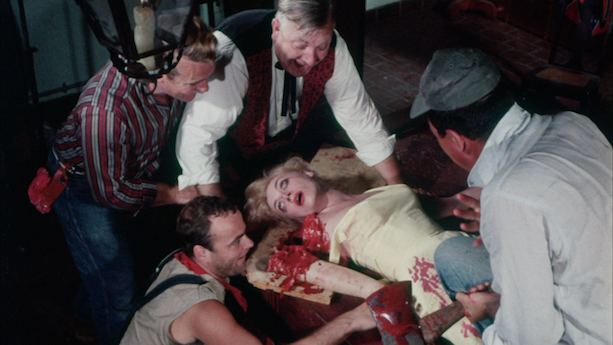
The next two features in the set have a slight "hicksploitation" theme, starting with Lewis's favorite film that he made, 1964's Two Thousand Maniacs!. Envisioned as a gory, red-state riff on Brigadoon, it concerns a small southern town that reappears every 100 years, after being brutally destroyed during the Civil War. The inhabitants celebrate their Centennial by killing as many Yankees as they can get their hands on, in as nasty a fashion as possible. Three tourist couples (including Blood Feast's Bill Kerwin and Connie Mason) are snared in the town's trap and are gradually picked off one by one. Lewis holds off any gore for nearly a half-hour before letting loose with kill scenes almost as memorable as Blood Feast's de-tonguing. Lewis shows a little more care with his storytelling in Two Thousand Maniacs! as well, which might explain why he's so proud of it.
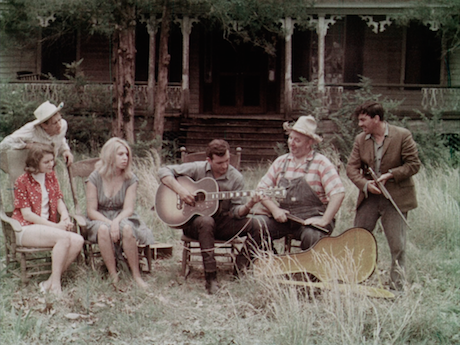
There's no real gore and only some tangentially horrific elements in Moonshine Mountain, also from 1964, but this flick is as strangely compelling as any of Lewis's gross-outs. To be honest, it is almost two movies in one, with the first half of the film a fish-out-of-water comedy and the second half a more decidedly disturbing thriller. Charles Glore, who appeared as part of a country-music Greek chorus in Two Thousand Maniacs!, stars here as urban folk music star Doug Martin. At the start of the film, Doug decides to go the Alan Lomax route and see if he can find some fresh ideas by making field recordings of hillbilly music down south. He ends up taken in by a family of bootleggers who like the way Doug picks his guitar. This leads to some genuinely good musical performances, including a right purdy version of the folk standard "Go Tell Aunt Rhody." The bootleggers are in cahoots with the town sheriff (Gordon Oas-Heim), who is so paranoid that federal agents will find out about the town's giant still that he basically becomes a mass murderer, getting rid of any outsider who crosses his path. The sheriff's method for disposing of the bodies makes no logical sense, but let's just say it's an amusing precursor to Farmer Vincent's business plan in Motel Hell.
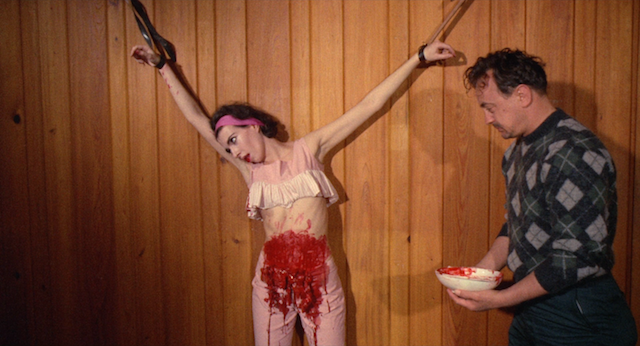
Color Me Blood Red, from 1965, completes what is informally known as "the Blood trilogy" (previously released on Blu-ray in 2011). This film also wound up being the last collaboration between Lewis and the producer of his past dozen films, David F. Friedman. (It was not a friendly parting, and it took a few decades before they would speak to each other again.) In a nutshell, Color Me Blood Red is a riff on Roger Corman's A Bucket of Blood, with Gordon Oas-Heim as a mad painter so obsessed with finding the proper shade of red that he starts killing people and draining their blood for it. Lewis's dark humor and frequent satirical jabs at art critics and gallery owners take precedence over elaborate kill scenes, making this probably the tamest of the "trilogy," but the sight of those blood-splattered canvases become genuinely unsettling. Also, the acting and filmmaking here are relatively more polished than normal, which means Color Me Blood Red is a better movie than many other entries in this set, even if the horror is not quite as gonzo.
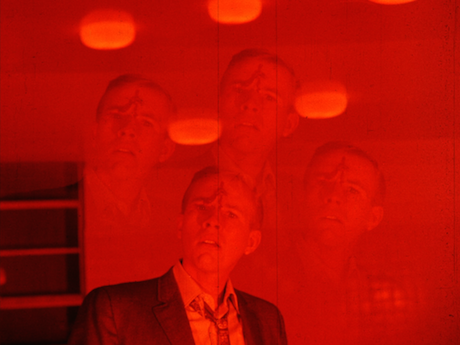
Next, we move to 1967 and Something Weird, a film that is such a mishmash of seemingly incompatible story ideas that it can't help but live up to its title. For example, the film features an early scene in a martial arts dojo that winds up not paying off in any way story-wise. The main character, Mitch, is electrocuted by a cut power line, which scars his face but gives him psychic powers. A witch -- yeah, that's right, a witch!! with off-color skin and warts on her face and everything!! -- makes a Faustian bargain with Mitch that she can give him back his beautiful face if he will become her lover. Why? Who knows. But vain Mitch goes along with it, and becomes a minor celebrity thanks to his high-quality ESP. In a scene that's a ramshackle precursor to both Ghostbusters and The Sixth Sense, Mitch is asked to rid a church of an errant spirit. Eventually, the cops and FBI decide to scout him as a potential investigator, and he is put on the trail of a sicko brutalizing women on the street (in one memorable moment, with a blowtorch [unconvincingly]). With an LSD dream sequence also tossed in there (it's effectively moody, to be fair), this flick has just about everything anyone going to see an exploitation flick in '67 would want. Whether they would want them all mixed together like this is a question for another time.
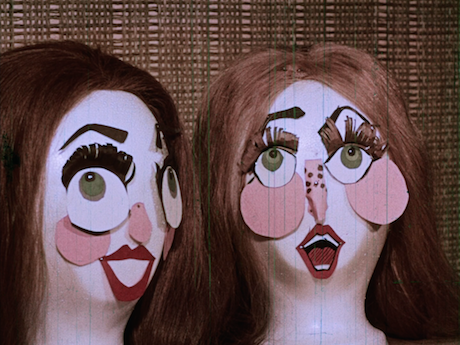
The Gruesome Twosome, also from '67, has some striking scenes, but it's in the running for Most Tedious Feature in the set. Lewis has a decent idea to begin with: a kooky old woman runs a wig shop, which she keeps stocked with the hair of young women she lures in to rent a nonexistent bedroom. Her mentally impaired son does the murdering and the hair harvesting, and thus completes the titular twosome. A college girl who has read too many Nancy Drew mysteries decides to investigate the recent spate of disappeared women. Sadly, Lewis does little to complicate her investigation, apart from a red herring involving an old foreign guy who buries soup bones in his backyard for his dog. Mostly, Lewis just pads the running time with irrelevant moments, like a dance scene in the women's college dorm and a dance scene on the beach. Admittedly, the two most memorable moments in the film are padding: a comic dialogue between two mannequin heads discussing the terrible fates of the women who originally owned their wig hair and a fake drive-in movie about a bizarre romantic dinner that suggests Lewis had maybe seen a few Robert Downey movies recently.
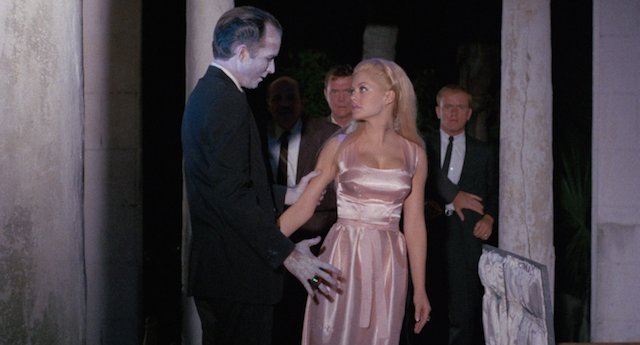
A Taste of Blood (also ALSO 1967) is a riff on Dracula that represents Lewis at his least idiosyncratic and his most stylistically ambitious. Businessman John A. Stone (the A is short for "Alucard," probably a reference to Son of Dracula or maybe a premonition of the music of Gentle Giant) receives a package from London saying that he has inherited an ancient estate, accompanied by some celebratory Slivovitz plum brandy. Little does Johnny Dracula realize, but the brandy is laced with vampire blood so that when he drinks it, he really starts to inherit his family's legacy. John is charged with eliminating the descendants of the do-gooders who stuck a stake in Count Dracula's heart, but he still takes the time to chomp on the neck of a stripper for kicks. Lewis does a pretty good job adapting his fast-and-sloppy tendencies to a slow-burn supernatural melodrama, but he's not able to coax consistent enough performances out of his cast (including a returning Bill Kerwin) to justify the flick's draggy pace and two-hour running time.
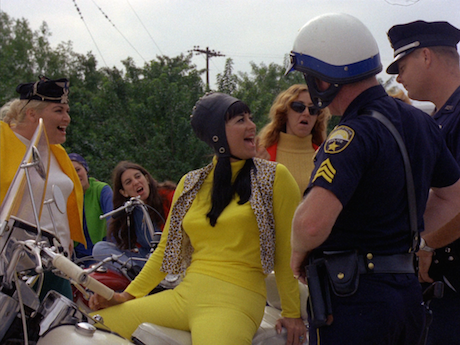
Herschell finds a new niche to exploit with 1968's She-Devils on Wheels, a lady biker-gang flick that doesn't quite topple the patriarchy, but offers a surprisingly good portrait of female camaraderie. The Man-Eaters is a biker gang with interests like most: racing, fighting, and screwing (not necessarily in that order). In other words, they are anything but a pack of wussy girls. In fact, when the main character shows feelings for a boy and looks like she might be too much of a "good girl," the gang forces her to drag this boy behind her bike until he is ripped to shreds. Absolutely no room for mushy stuff in the Man-Eaters! When a male gang threatens the Man-Eaters' territory, these biker chicks beat the fellas up and piss on their heads (although the film semi-tastefully cuts away to a running shower head at the key moment). The flick has enough personality and verve to easily overcome the fact that it has nearly as many less-than-thrilling wide shots of zooming motorcycles as The Brown Bunny.
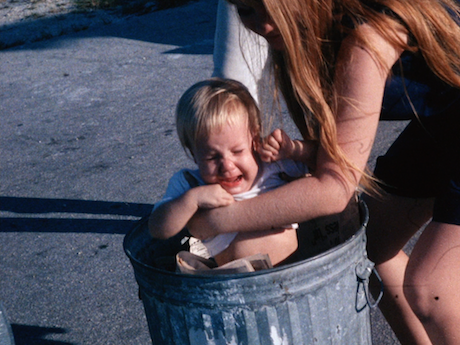
"Destruction porn" is how filmmaker Chris Alexander describes Just for the Hell of It (also from '68) in the bonus supplements, and that's pretty apt. Lewis hedges his bets by including a few scenes with authority figures discussing the scourge of juvenile delinquents (as though the film had been made a good decade and a half earlier, when delinquency was all the rage), but mostly Just for the Hell of It consists of disconnected scenes of a ragtag teenage gang wreaking havoc on their town. The opening of the film is a four-minute sequence where the kids close out a house party by pulverizing every stick of furniture in sight. Later, they steal a blind man's cane and rough him up. They stick a baby in a trash can and bust up his stroller. They walk into a random office and tear up an elderly employee's paperwork. They get into a brawl in a coffee shop, THEN they wreck the joint, THEN they press the owner's hands down on the hot grill as the coup de grace. Many of the sequences are queasily compelling or unforgettably bizarre, but the film is so scattershot and sadistic (but not in the fun way the gore movies are) that it gradually turns into the set's most difficult flick to sit through.
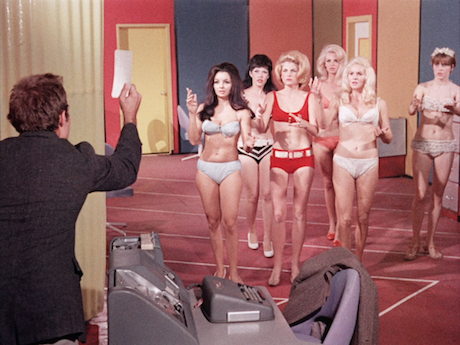
"Could it be that girls are better than textbooks? I wonder what mother would say." How to Make a Doll is a charmingly stupid sex comedy that also originates from the productive year of 1968. A nerdy young professor is oblivious about girls; he doesn't even notice when students in class start making out in front of him. His mentor, a pioneer in the field of Weird Science, has completed work on a machine that can synthetically generate life, and starts cranking out sexy fembots. Then the old man forces the young prof to take part in some virtual reality sex parties -- or something? Full disclosure: While there are some enjoyably goofy jokes scattered throughout, I had trouble paying full attention to this one because it's all pretty silly and arbitrary. In his newly-recorded intro to the film, H.G. Lewis basically says he made this movie as a favor to a friend and wasn't all that invested in the story. It shows.
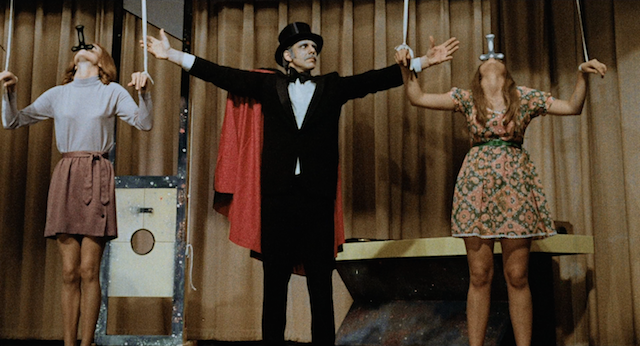
Splatter gets surreal in 1970's The Wizard of Gore, a nifty bit of horror showmanship that paved the way for Joel M. Reed's Bloodsucking Freaks. Ray Sager stars as Montag the Magnificent, a spooky magician who hypnotizes and then graphically eviscerates his female volunteers onstage, before seemingly returning their bodies to normal. However, his hapless victims all inevitably succumb to their injuries once the show is over. For example, a woman is sawn in half with a power saw, seemingly put back together, but then unexpectedly bisects again once she arrives at a restaurant for dinner. TV personality Sherry Carson is fascinated by Montag and wants to put him on her show, but Sherry's reporter boyfriend is suspicious. Like A Taste of Blood, Wizard of Gore attempts to evoke a moody, hypnotic atmosphere between graphic kills, and Lewis arguably pulls it off this time. Ray Sager does a surprisingly excellent job of commanding the screen during Montag's many over-the-top monologues to the audience, and he performs his "illusions" with a ritualistic steadiness that successfully builds a feeling of dread. The ending of the film makes no damn sense, but this is a definite highlight even so.
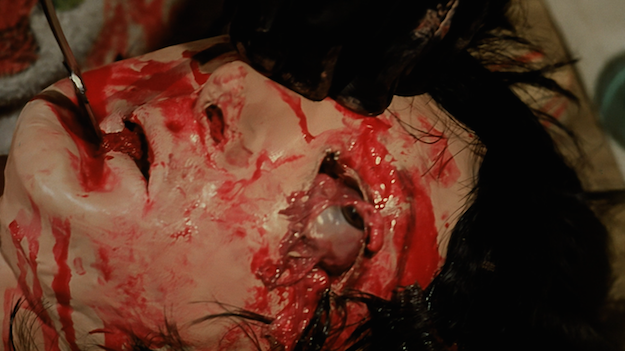
The second-to-last entry in the set is the last film H.G. Lewis made in the 20th Century, the private eye/slasher/striptease comedy The Gore Gore Girls (1972). Since Herschell figured this was going to be his last film (he unexpectedly came back three decades later with Blood Feast 2), he throws in the kitchen sink. Eyeballs are popped out and squeezed, a face gets fried in oil, a butt is destroyed by a meat tenderizer, nipples get snipped and two kinds of milk spurt out. It's mostly done with tongue planted firmly in cheek -- this is hands-down the funniest movie in the set -- but I recommend watching the film on an empty stomach, just to be safe. And here's an odd sidenote: comic Henny Youngman appears as the owner of a strip club in the film, although he denied it years later. Hey, Henny! We can see you in the movie.
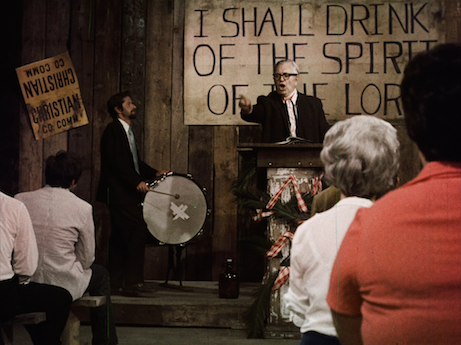
Last up is another hicksploitation flick, This Stuff'll Kill Ya! (1971). Lewis regular Talky Blank (screen name: Jeffrey Allen) pops up again as a charismatic charlatan preacher who corrupts his congregation and fronts a bootlegging operation. Some folks end up dead, a few ladies end up crucified. Eh... this one also doesn't make a whole lot of sense. Clearly down-on-his-luck former star Tim Holt (Treasure of the Sierra Madre) plays a Federal man who tries to put the kibosh on the preacher's "good work." Darkman's Larry Drake also pops up as an unsavory parishioner named Bubba.
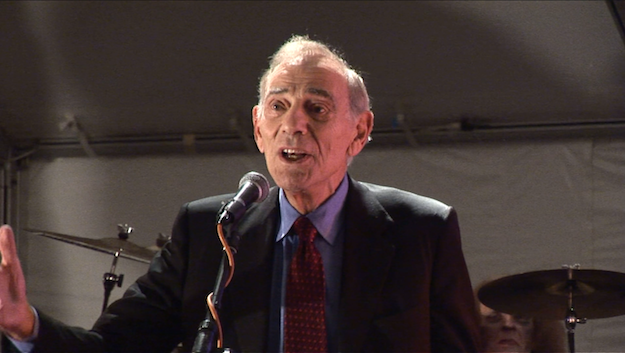
The Blu-ray
The Herschell Gordon Lewis Feast consists of 10 Blu-rays and 7 DVDs. The 14 films are packaged as double-feature discs in both formats, with most of the special features sprinkled throughout where applicable. The remaining three Blu-rays, exclusive to this set, contain open-matte 1.33:1 versions of five films and the 2010 documentary The Godfather of Gore (see "Special Features" below). The discs are packaged in a mock cereal box, along with a hardbound book that is full of activities (yes, activities!) and beautifully reproduced promo art. Rather than try to describe it all, I'm going to direct you to this thorough unboxing video that shows off the set's design bells and whistles.
The Video & Audio:
The A/V quality is a mixed bag on this set, which is partially due to the inborn flaws of the original productions and partially due to the lack of care that has been taken over the years to preserve these movies. Many of the films are prefaced by a disclaimer saying that Arrow attempted to correct some of the damage, but that they didn't want to sacrifice the natural look of the film grain by doing heavy digital alterations. The films are all presented with AVC-encoded 1080p transfers and LPCM mono audio; the quality of the audio generally matches the quality of the image, with the most beat-up looking films also sounding the worst.
In a nutshell, the two best-looking and -sounding films are Blood Feast and She-Devils on Wheels, which coincidentally are Herschell's two biggest hits. The next step down, still offering vivid color, but with a little more noticeable damage are Color Me Blood Red and Just for the Hell of It. The two worst-looking and -sounding are Moonshine Mountain and The Gruesome Twosome, which are consistently scratched and damaged throughout. Moonshine includes some SD video to fill in missing shots, and Twosome also has many patches of discoloration and sections that have gone pink over time. Most everything else fits in between those two extremes, typically with strong clarity (thanks to a 2K digital scan of film materials), but often dogged with damage and/or faded colors and/or image density issues.
Two Thousand Maniacs! and The Gore Gore Girls have HD masters that did not originate in-house at Arrow and have their own idiosyncrasies. Maniacs! looks quite good for the most part, but it has a bunch of those SD video drop-ins to fill in missing frames, which can be distracting. Gore Gore meanwhile looks like it has had digital smoothing and edge enhancement applied to it.
Half of the films are presented in the original open-matte 1.33:1 aspect ratio. Blood Feast, Scum of the Earth, Color Me Blood Red, A Taste of Blood, and The Wizard of Gore are presented in a widescreen 1.85:1 ratio. Two Thousand Maniacs! and The Gore Gore Girls have both been cropped to 1.78:1.
All the features have one subtitle option: English SDH, although the British transcribers don't always catch the nuances of American vernacular. This means that they sometimes substitute slang with incorrect words, even when the dialogue seems pretty obvious. I mean, what kind of person hears "Go fumigate yourself, craphead" (from She-Devils on Wheels) and believes it's actually "Go fumigate yourself, graph-head"?
Special Features:
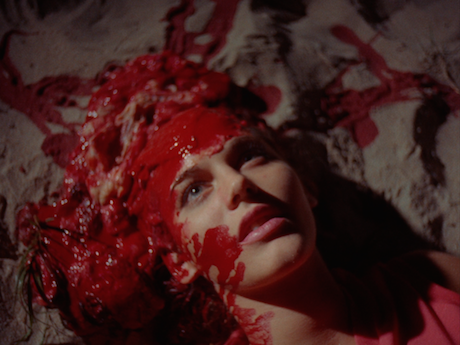
- Open-matte 1.33:1 versions of Blood Feast, Scum of the Earth, Color Me Blood Red, A Taste of Blood, and The Wizard of Gore - Spread across discs 15 and 16 of the set, these full-screen versions are exclusive to the box set. It's a shame we don't get this option for Two Thousand Maniacs! and The Gore Gore Girls, but it appears those HD masters were not made in-house at Arrow.
- Herschell Gordon Lewis: The Godfather of Gore (HD upscale, 1:46:18) - A feature-length documentary by Jimmy Maslon and Basket Case's Frank Henenlotter about Herschell Gordon Lewis's '60s and '70s film career, previously released on DVD in 2011.
- The Godfather of Gore Deleted Scenes (HD upscale, 1:04:18) - More excellent interview tidbits and ephemera.
- The Godfather of Gore trailer
- Audio commentaries on 10 films - All ported over from the early-'00s Something Weird DVDs, these commentaries feature the rotating cast of Herschell Gordon Lewis, David F. Friedman, Something Weird Video founder Mike Vraney, and Jimmy Maslon from Shock Films. Lewis is a born raconteur, and he clearly loves to share old showbiz gossip, so all these discussions are a treat. The Something Weird track is a little unusual, because Vraney uses up most of the running time to recount the history of his exploitation home video label that took its name from Lewis's film. This Stuff'll Kill Ya! is also a little unusual, as it features only Daniel Krogh, who worked as a cameraman on Lewis's last few films.
- Herschell Gordon Lewis intros to all 14 films (HD, 22:48 total) - Herschell offers a little history and a lot of opinions about each of the featured films. Sometimes he also throws in a headscratcher like this: "If you have seen more than one of my films, then you probably have not seen this one."
- Blood Feast Deleted Scenes (HD upscale, 45:55) - A collection of silent, unused trims (accompanied on the soundtrack by unrelated music cues and dialogue), including alternate angles, effects flubs, and unintended nudity.
- Scum of the Earth "Clean Scenes" (HD upscale, 4:36) - Just what it sounds like: PG-rated alternates for a few of the flick's spicier moments.
- Blood Perspectives (HD, 10:54) - Directors Nicholas McCarthy (The Pact) and Rodney Ascher (Room 237) offer their memories of first experiencing Blood Feast and their appreciation for Lewis's work over the years.
- Herschell's History (HD, 5:18) - A fairly recent interview, where Lewis talks about his start in the business and his work on Scum of the Earth.
- How Herschell Found His Niche (HD, 7:15) - Lewis discusses how his partnership with producer David Friedman began on the "nudie cutie," The Adventures of Lucky Pierre.
- Archival Interview with H.G. Lewis and David Friedman (HD upscale, 18:28) - A 1987 interview with the filmmaking duo, waxing nostalgic, that is as warm and wisecrack-filled as their shared commentaries.
- Carving Magic (HD, 20:31) - An amusing '50s how-to film directed by Lewis, featuring appearances by Lewis's go-to actor Bill Kerwin and future comedy superstar Harvey Korman. It concerns the proper methods for carving up meat and is oddly entrancing.
- Two Thousand Maniacs! outtakes (HD upscale, 16:28) - More random silent trims, accompanied by unrelated music and dialogue from the film.
- Two Thousand Maniacs Can't Be Wrong (HD, 9:54) - Tim Sullivan, the director of 2001 Maniacs, offers his appreciation for the film he remade.
- David F. Friedman: The Gentleman's Smut Peddler (HD, 9:22) - An appreciation of producer Friedman, with talking heads from Lewis, director Fred Olen Ray, Tim Sullivan, and Grindhouse Releasing's Bob Murawski.
- Herschell's Art of Advertising (HD, 3:33) - Lewis holds forth on how the modern film industry has lost touch with the good old-fashioned showmanship of movie-selling.
- Hicksploitation Confidential (HD, 7:14) - David Del Valle narrates this short essay on the way Hollywood has represented Southern characters, from The Birth of a Nation to Black Snake Moan, and touching on Two Thousand Maniacs! along the way.
- The Art of Madness (HD, 5:35) - Another essay narrated by David Del Valle, providing a survey of films about mad artists. Oddly, the recent Arrow release Blood Bath does not get a name check, although it would comfortably fit right in with the theme.
- Color Me Blood Red outtakes (HD upscale, 9:36) - More silent trims, accompanied by audio from other H.G. Lewis flicks. This mostly focuses on the sequence where an unfortunate teenage boy gets harpooned.
- Weirdsville (HD, 10:31) - Film professor Jeffrey Sconce offers an appreciation of Something Weird as a wildly unexpected entry in Lewis's filmography. He points out (and I agree) that Lewis's claim that he only ever produced movies as a money-making venture falls apart when assessing Something Weird, because the movie is so ambitious and odd, especially within an exploitation context, that it feels like personal artistic expression.
- H.G. Lewis on Jimmy, the Boy Wonder (HD, 2:10) - Lewis talks about a kiddie flick he made in 1966, between Color Me Blood Red and Something Weird.
- A Hot Night at the Go Go Lounge! (HD, 10:07) - A 1966 short, full of young folks twisting and shimmying at a nightclub, before segueing into some topless ladies doing the same thing in a studio. No credits, so Arrow offers a disclaimer that this film is "presumed to be directed by Lewis."
- Peaches Christ Flips Her Wig! (HD, 9:54) - Drag performer and underground filmmaker Peaches Christ talks about how H.G. Lewis's movies were a seminal part of her growing up and offers an appreciation of The Gruesome Twosome's campiness.
- It Came From Florida (HD, 10:48) - Hollywood Chainsaw Hookers auteur Fred Olen Ray discusses the regional exploitation film community in his home state.
- Herschell Versus the Censors (HD, 7:43) - Lewis discusses navigating through the world of local censorship authorities during his career heyday. He also gets in a sick burn at Keanu Reeves's expense.
- The Shocking Truth! (HD, 10:25) - Grindhouse Releasing's Bob Murawski offers his impressions of Lewis and his films.
- Garage Punk Gore (HD, 9:12) - Musician and Queen of Blood director Chris Alexander highlights Lewis's outsider nature, how Lewis was a precursor to director-film composers like John Carpenter and Robert Rodriguez, and how he once performed "The South's Gonna Rise Again" from Two Thousand Maniacs! onstage with Alexander backing him up.
- H.G. Lewis on The Alley Tramp (HD, 2:58) - Lewis discusses a work-for-hire job, directing a teensploitation flick in 1968, between She-Devils on Wheels and Just for the Hell of It.
- Montag Speaks! (HD, 19:33) - A new interview with Ray Sager, star of Wizard of Gore and also an actor and a crew member on a bunch of Herschell's movies. Included in his many anecdotes, he talks about working with Colonel Sanders on Blast-Off Girls, pretending to know how to drive a car for Just for the Hell of It, and frightening a family in mourning on Wizard of Gore.
- Stephen Thrower on The Wizard of Gore (HD, 10:20) - Thrower, a historian and curator of the American Horror Project, offers a thoughtful rundown of how Wizard was made.
- The Gore The Merrier (HD, 9:05) - Jeremy Kasten, who directed the 2007 remake of The Wizard of Gore, talks about why he thinks the original is a disjointed but brilliant film.
- The Incredibly Strange Film Show episode (40:03) - A 1988 British TV documentary series, hosted by Jonathan Ross, takes a look at Herschell's work. Includes talking heads from John Waters, Bill Kerwin, David F. Friedman, and more.
- Stephen Thrower on The Gore Gore Girls (HD, 16:25) - Thrower offers some interesting history and analysis of Gore Gore, including his reading that the film is essentially H.G. Lewis's version of an Italian giallo.
- Regional Bloodshed (HD, 12:06) - Filmmakers Joe Swanberg and Spencer Parsons talk about H.G. Lewis's unique place in the history of regionally specific indie filmmakers.
- Herschell Spills His Guts! (HD, 4:02) - Lewis talks about why he got out of the movie business and went into marketing after The Gore Gore Girls.
- Promo galleries - They include trailers for flicks in the set like Blood Feast, Two Thousand Maniacs!, Moonshine Mountain, Color Me Blood Red, Something Weird, The Gruesome Twosome, A Taste of Blood, She-Devils on Wheels, The Wizard of Gore, and This Stuff'll Kill Ya!; and trailers for flicks not in the set like The Adventures of Lucky Pierre, Goldilocks and the Three Bares, Bell, Bare, and Beautiful, Jimmy, the Boy Wonder, and The Alley Tramp. Also included are radio spots for Blood Feast, a Something Weird/The Gruesome Twosome double feature, and She-Devils on Wheels, plus a Blood Feast theater announcement.
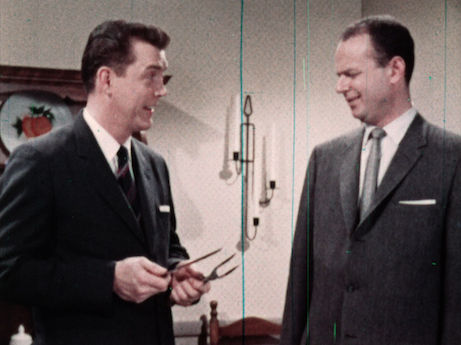
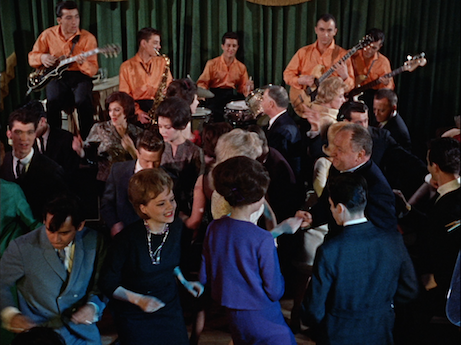
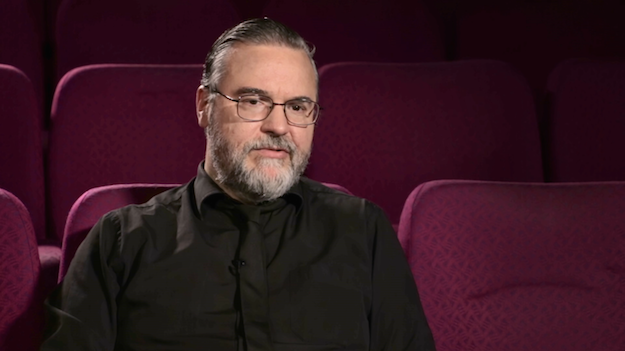
Final Thoughts:
The mock-cereal-box packaging of The Herschell Gordon Lewis Feast is an art object that deserves to be in the home of every splatter film fan. The salesmanship of the packaging is as much a tribute to Herschell Gordon Lewis as the discs inside. (Some might argue that the packaging is more fun than the films too, but I'll let them speak for themselves.) Lewis's filmmaking style (think outsider art resulting from mercenary indifference) is not for everyone. But if you count yourself as member of the Lewis cult, this box set is a treasure trove and a mammoth achievement. DVD Talk Collector Series.
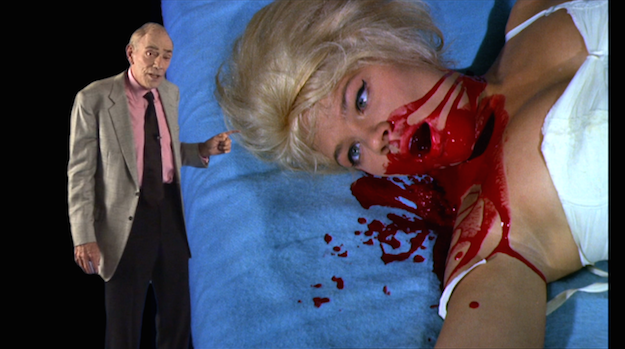
Justin Remer is a frequent wearer of beards. His new album of experimental ambient music, Joyce, is available on Bandcamp, Spotify, Apple, and wherever else fine music is enjoyed. He directed a folk-rock documentary called Making Lovers & Dollars, which is now streaming. He also can found be found online reading short stories and rambling about pop music.
|
| Popular Reviews |
| Sponsored Links |
|
|
| Sponsored Links |
|
|
| Release List | Reviews | Shop | Newsletter | Forum | DVD Giveaways | Blu-Ray | Advertise |
|
Copyright 2024 DVDTalk.com All Rights Reserved. Legal Info, Privacy Policy, Terms of Use,
Manage Preferences,
Your Privacy Choices | |||||||















